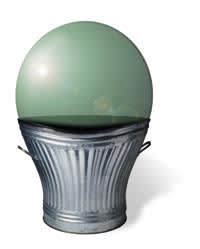
|
|
Stop Throwing Premium Product Away�Eliminate Re-dos
By Susan P. Tarrant
Thin and light. Coatings. Tints. Progressive adds on very small lenses. Those are the things that premium lens jobs are made of these days. Those are also the things that revenue is made of these days.
Yet to have to start over when those jobs are not executed perfectly costs money. Money that adds up over time as the re-do rate soars.
Eyecare Business asked some of the industry's equipment experts about some common problems associated with processing premium lens product in-house, and asked them to provide some tips for reducing-or eliminating altogether-a rather expensive problem.
Off its Axis
PROBLEM: Sometimes when we're edging AR coated lenses, the blocking slips, which knocks the axis off and we have to redo the lens.
SOLUTION: Slippage during the blocking phase happens because the lenses become hydrophobic when AR coated, meaning there can be a slight amount of moisture on the lens.
Therefore, the adhesive tape used prior to blocking can slip, which causes the blocker to slip and the lens to be knocked off axis.
There is a special adhesive disk that can be put on the lens prior to the blocking phase that will eliminate this problem. This "surface saver tape" is smaller in diameter than the lens, but bigger than the block. It allows the adhesive tape to adhere better to the lens, which prevents the block from slipping.
An added benefit is the surface saver tape also helps protect the coated lens from being scratched.
3M manufacturers the tape, but so do others, I believe.
-Bill Galindo, president, ODI/Topcon
Crack and Craze
PROBLEM: How can I avoid cracking and crazing when dealing with AR coated lenses?
SOLUTION: Unless you have an edger that has an automatic "fragile lens" setting, don't try to use a one-cut approach to edging an AR coated lens.
The best way to handle this type of lens is with multiple cuts. Start by oversizing the lens at the beginning of the cutting cycle. Then slowly remove small amounts of material, downsizing until you get to the target shape. The advantage of using an edger that has a "fragile lens" setting is that it basically does this for you by slowing the lens rotation speed and lens drop rate automatically, so that even inexperienced operators can achieve the desired results.
-Greg Dean, technical training manager, Briot USA
High Index, High Error Rate?
PROBLEM: When processing high index lenses, our automatic edger cuts the lenses a little too big, forcing a retouch, or worse-a re-do.
SOLUTION: High index is a much more dense material than CR 39. Therefore, if you're dealing with an automatic machine and set it for "plastic," the lens will be cut a little big. If you are working with an edger that has a separate setting for high index, you're all set.
Many machines don't have a separate setting for high index. In that case, simply create a conversion chart. Keep track of the margin of error you are experiencing for each lens index. That error should be consistent. For example, every time you cut a 1.60 lens, the finished lens should be a certain number off every time. Keep track of that error margin, and you should be able to avoid retouching the lens by simply entering the "converted" number into your machine before you even begin.
Eliminating the need to retouch reduces the number of times the lens has to be handled, which also reduces probability of other errors occurring.
-Rick Noonkester, regional manager, Santinelli International
Re-do Resolution
PROBLEM: Our office is doing a lot more premium product, yet our re-do rates are through the roof.
SOLUTION: The best way to eliminate the re-do rate is to make sure your office is investing in and taking advantage of the better processing technology that is available.
If the lab is an integral portion of your business, and you recognize keeping jobs in-house as important to your practice, that's one of the reasons why investing in technology is so vital.
On average, an in-house lab will see a savings of about $15 per job. That figure goes up considerably when you bring the premium jobs in-house. But you've got to have the right equipment to handle it.
In general, you should look for the newest generation patternless edger with 3-D technology. It should also have an integrated blocker, one that gives your tech the ability to input the prescription information, and it will line everything up automatically.
Because of the popularity of high index lenses, and with the future moving toward the thin lenses and fragile edges, the equipment should also give you the ability to adjust the chuck pressure and adjust the head pressure. It is important to have the capability to make those adjustments on a job-to-job basis, not just once.
-Matt Vulich, vice president, sales, AIT Technologies EB
Got a question you'd like answered in a future "Eye on Equipment" column? Send it now!



